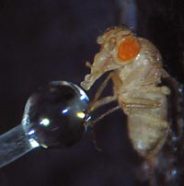Fruit flies taste water
A protein helps tell the brain, 'Got water.'
If you ask most people what water tastes like, they’ll probably tell you that water has no taste (and they may give you a funny look). But if you were a fruit fly, asking another fruit fly, that question might have a different answer.
To a fruit fly, water has a taste (though it would probably be hard to describe). Scientists have long known this fact, but a recent study goes one step further. A team of biologists led by Peter Cameron at the University of California, Berkeley recently figured out how a fruit fly tastes water — and how its brain detects that water is near.
Scientists want to know how the fruit fly knows water because this information may help in learning how other animals — or even individual cells — manage to use water in the right way. Water is vital to life, but too much or too little can be deadly to a living creature. So by understanding how the fruit fly tastes water, researchers may learn more about other living things.
According to the new study, a protein called PPK28 makes it possible for a fly to taste water. Proteins are molecules that do most of the work in a living organism. Proteins build cells and tissues, fight disease and carry messages between cells. It’s not surprising that a protein is responsible for the fruit fly’s ability to taste water, but Cameron and his colleagues were the first ones to find it.
 |
|
A fruit fly uses its proboscis to taste and take in food.
|
| Kristin Scott/UC Berkeley |
The biologists found this protein in a cell in the fruit fly’s feeding tube, or proboscis. The feeding tube is a long and thin organ that the fly can extend when it wants to taste something.
The PPK28 protein is part of a larger family of similar proteins. One of these related proteins is used by mammals (including humans) to taste salt. However, none had ever been shown to help an animal taste or detect water.
That may change: It’s possible that related proteins have similar tasks in the cells of mammals, Charles Bourque told Science News. Bourque, who works at the Centre for Research in Neuroscience at McGill University in Montreal, Canada, did not work on the study with Cameron.
Scientists have not found a protein that enables humans to “taste” water.
In the experiment, Cameron and his team compared normal fruit flies with fruit flies whose taste cells had been disabled. The fruit flies were given a special chemical that would glow when the fly used the PPK28 protein. Then the scientists led the flies to water. When the normal flies tasted the water, the PPK28 protein lit up — showing that it was in use. Cameron also found that fruit flies without the protein PPK28 did not drink for as long as flies with the protein did.
The fruit fly is one of the most studied organisms in the world, and scientists have learned a lot about life from these tiny insects. Cameron’s study is a good example of how science can produce a lot of information about a tiny organism. The fruit fly in particular is so interesting that some scientists are hard at work creating a complete map of the fruit fly brain. This map will show all of a fly’s neurons and help scientists understand how the neurons work together.
Nicholas Ryba, head of the Laboratory of Sensory Biology of the National Institutes of Health in Bethesda, Md., told Science News, “This is a very beautiful study with a huge amount of detail.”







